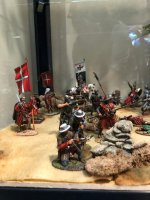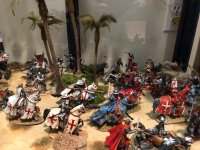bradleyl30
Command Sergeant Major
- Joined
- Oct 17, 2012
- Messages
- 2,575
So, this could be representative of multiple battles including Arsuf, La Forbelet, Montgisard (sort of) and many other smaller battles. Also, what probably should have happened at the Springs of Sephonie rather than marching to the Horns of Hattin for the single most crushing defeat of the Army of Jerusalem.
More than the Saracen armies, the armies of Jerusalem, other Crusader states and the Franks / Latins were dependent on staying close to water. They were very successful as long as they followed a few crucial rules:
1. Stay close to water and supplies since their heavier forces required more of it.
2. Protect the Knights / Men-at-Arms and their horses with archers (distance and speed) and crossbowmen (distance, patience and precision)
3. Protect the archers and crossbowmen with spearmen with big shields, big kettle helms and armor (metal or padded.)
4. Wait until the Saracens attack and get too close (since their arrows are not having much impact if you are following 1 through 3)
5. Then unleash the heavy horse against Saracens who have gotten too close on horses that are starting to get tired (timing crucial)
6. As soon as the heavy horse makes contact send lighter forces in to support (once the horses bog down they become more vulnerable, though lack of mud helps keep them nimble and fighting, as long as they are well watered and fed - see #1)
7. Once the impact of the heavy horse starts to stall, withdraw back to your starting point or new defensive line manned by your archers, crossbowmen and spearmen because you are always out numbered and the Saracens will send fresh troops - never over extend!
8. Draw the Saracens back to your fixed archers and crossbowmen protected by big shields who will cut the horse archers down. break formation and you die!
Usually, you have good enough ground as long as you stay on the coastal plain or in the populated areas of the inland highlands. Get too far from these areas and you are in open country with a long and vulnerable supply chain, and then you die like at Hattin.


More than the Saracen armies, the armies of Jerusalem, other Crusader states and the Franks / Latins were dependent on staying close to water. They were very successful as long as they followed a few crucial rules:
1. Stay close to water and supplies since their heavier forces required more of it.
2. Protect the Knights / Men-at-Arms and their horses with archers (distance and speed) and crossbowmen (distance, patience and precision)
3. Protect the archers and crossbowmen with spearmen with big shields, big kettle helms and armor (metal or padded.)
4. Wait until the Saracens attack and get too close (since their arrows are not having much impact if you are following 1 through 3)
5. Then unleash the heavy horse against Saracens who have gotten too close on horses that are starting to get tired (timing crucial)
6. As soon as the heavy horse makes contact send lighter forces in to support (once the horses bog down they become more vulnerable, though lack of mud helps keep them nimble and fighting, as long as they are well watered and fed - see #1)
7. Once the impact of the heavy horse starts to stall, withdraw back to your starting point or new defensive line manned by your archers, crossbowmen and spearmen because you are always out numbered and the Saracens will send fresh troops - never over extend!
8. Draw the Saracens back to your fixed archers and crossbowmen protected by big shields who will cut the horse archers down. break formation and you die!
Usually, you have good enough ground as long as you stay on the coastal plain or in the populated areas of the inland highlands. Get too far from these areas and you are in open country with a long and vulnerable supply chain, and then you die like at Hattin.









